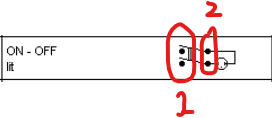Hello,
I'm in Europe with 240 V mains. I'm not certain, but I think it is correct to call the blue wire "load", the brown wire "neutral", and the green/yellow wire "protective earth". For each heating element I'm using an illuminated DPST illuminated rocker switch combined with a SSR. I wanted to have the switch LED light up when the SSR is powering the heating element. As I have it now, the switch LED illuminates whenever the switch is closed. The SSR is switching the heating element as desired, but this has no effect on the switch led.
I have the blue wire going first to the SSR and then to one pole of the switch and from the switch to the outlet for the heating element. I have the brown wire going to the other pole of the switch and from the switch to the outlet for the heating element. The yellow/green wire goes directly to the outlet for the heating element.
edit: On the other hand I have the same switches on both my pump and HLT mixer. In these cases there are no relays, there is only this switch between mains and the respective outlet and I am switch both brown and blue wires on each of the 2 poles. Here the switch is constantly illuminated regardless of it's position. The pump and mixer operate properly when the switch is closed.
What am I missing?
Thanks for your help
I'm in Europe with 240 V mains. I'm not certain, but I think it is correct to call the blue wire "load", the brown wire "neutral", and the green/yellow wire "protective earth". For each heating element I'm using an illuminated DPST illuminated rocker switch combined with a SSR. I wanted to have the switch LED light up when the SSR is powering the heating element. As I have it now, the switch LED illuminates whenever the switch is closed. The SSR is switching the heating element as desired, but this has no effect on the switch led.
I have the blue wire going first to the SSR and then to one pole of the switch and from the switch to the outlet for the heating element. I have the brown wire going to the other pole of the switch and from the switch to the outlet for the heating element. The yellow/green wire goes directly to the outlet for the heating element.
edit: On the other hand I have the same switches on both my pump and HLT mixer. In these cases there are no relays, there is only this switch between mains and the respective outlet and I am switch both brown and blue wires on each of the 2 poles. Here the switch is constantly illuminated regardless of it's position. The pump and mixer operate properly when the switch is closed.
What am I missing?
Thanks for your help
Last edited:









![Craft A Brew - Safale BE-256 Yeast - Fermentis - Belgian Ale Dry Yeast - For Belgian & Strong Ales - Ingredients for Home Brewing - Beer Making Supplies - [3 Pack]](https://m.media-amazon.com/images/I/51bcKEwQmWL._SL500_.jpg)


















































